
Captains Courageous: A Story of the Grand Banks is an 1897 novel by Rudyard Kipling that follows the adventures of fifteen-year-old Harvey Cheyne Jr., the spoiled son of a railroad tycoon, after he is saved from drowning by a Portuguese fisherman in the North Atlantic. The novel originally appeared as a serialisation in McClure's, beginning with the November 1896 edition with the last instalment appearing in May 1897. In that year, it was published in its entirety as a novel, first in the United States by Doubleday, and a month later in the United Kingdom by Macmillan. It is Kipling's only novel set entirely in North America. In 1900, Teddy Roosevelt extolled the book in his essay "What We Can Expect of the American Boy", praising Kipling for describing "in the liveliest way just what a boy should be and do".

USS Saratoga, a sloop-of-war, was the third ship of the United States Navy to be named for the Battle of Saratoga of the American Revolutionary War. Her keel was laid down in the summer of 1841 by the Portsmouth Navy Yard. She was launched on 26 July 1842 and commissioned on 4 January 1843 with Commander Josiah Tattnall III in command.

Operation Jaywick was a special operation undertaken in World War II. In September 1943, 14 commandos and sailors from the Allied Z Special Unit raided Japanese shipping in Singapore Harbour, sinking six ships.
Richard Ingle (1609–1653) was an English seaman, tobacco trader, privateer, and pirate in colonial Maryland. Along with another Protestant rebel, Captain William Claiborne, Ingle waged war against Lord Baltimore and Maryland Catholics in the name of English Parliament after his ship was seized and confiscated, siding with the Maryland Puritans in a period known as the "Plundering Time" during which unrest and lawlessness were widespread in the colony. Ingle and his men attacked ships and captured the colonial capital of the proprietary government in St. Mary's City, removing the Catholic Governor Lord Baltimore from power, in 1645. Most of Ingle's life and background are unknown.
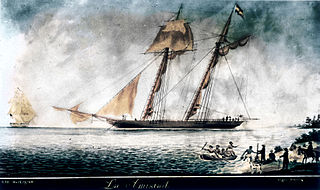
La Amistad was a 19th-century two-masted schooner owned by a Spaniard living in Cuba. It became renowned in July 1839 for a slave revolt by Mende captives who had been captured and sold to European slave traders and illegally transported by a Portuguese ship from West Africa to Cuba, in violation of European treaties against the Atlantic slave trade. Spanish plantation owners Don José Ruiz and Don Pedro Montes bought 53 captives in Havana, Cuba, including four children, and were transporting them on the ship to their plantations near Puerto Príncipe. The revolt began after the schooner's cook jokingly told the slaves that they were to be "killed, salted, and cooked." Sengbe Pieh unshackled himself and the others on the third day and started the revolt. They took control of the ship, killing the captain and the cook. Two Africans were also killed in the melee.
Joseph Baker [Joseph Boulanger] was a Canadian pirate, known primarily for the failed mutiny and hijacking of the merchant schooner Eliza in 1800.
Duke of Portland was an American whaler of 400 tons.
SS Earnmoor was a tramp steamer that sank during a storm in 1889. The survivors drifted for 21 days in an open boat and were allegedly forced into cannibalism to survive.
Laurens Prins, anglicized as Lawrence Prince, was a 17th-century Dutch buccaneer, privateer and an officer under Captain Sir Henry Morgan. He and Major John Morris led one of the columns that raided Panama in 1671.
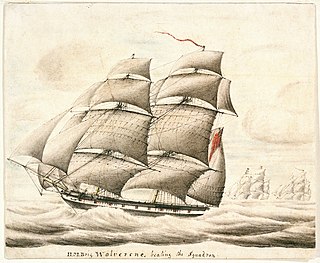
HMS Wolverine was a Royal Navy 18-gun Cruizer-class brig-sloop, launched in 1805 at Topsham, near Exeter. Early in her career she was involved in two fratricidal incidents, one involving a British frigate and then a newsworthy case in which she helped capture a British slave ship. She later captured a small naval vessel and several privateers, and took part in the invasion of Martinique, and during the War of 1812, in the attack on Baltimore. Wolverine was decommissioned in August or September 1815 and was sold on 15 February 1816.
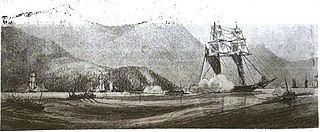
The action of 1 January 1800 was a naval battle of the Quasi-War that took place off the coast of present-day Haiti, near the island of Gonâve in the Bight of Léogâne. The battle was fought between an American convoy of four merchant vessels escorted by the United States naval schooner USS Experiment, and a squadron of armed barges manned by Haitians known as picaroons.

John Handran (1852-1885) was a United States Navy sailor and a recipient of the United States military's highest decoration, the Medal of Honor.

African Slave Trade Patrol was part of the Blockade of Africa suppressing the Atlantic slave trade between 1819 and the beginning of the American Civil War in 1861. Due to the abolitionist movement in the United States, a squadron of U.S. Navy warships and cutters were assigned to catch slave traders in and around Africa. In 42 years about 100 suspected slave ships were captured.

Bering Sea Anti-Poaching Operations were conducted in 1891 by the navies and marine corps' of the United States and the United Kingdom of Great Britain and Ireland. Due to the near extinction of the seal population in the Bering Sea, the American and British governments dispatched a squadron of warships to suppress poaching activities, under the command of United States Navy Commander Charles S. Cotton.

The Ivory Coast expedition, or the Liberia expedition, was a naval operation in 1842, launched by the United States against the West African Bereby people. After the attacks on the merchant ships Mary Carver and Edward Barley, the American Congress approved a punitive expedition to the area and placed Commodore Matthew C. Perry in command. The expedition was successful in exacting redress by destroying the fortified town of Little Bereby and by killing the chief responsible for the attacks on American shipping.
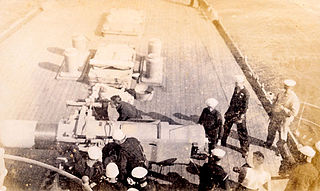
The Santo Domingo Affair, or the Santo Domingo Crisis, refers to an incident in 1904 involving the United States and Dominican militia forces in the Dominican Republic. After the death of a seaman from the USS Yankee on February 1, the U.S. military launched a punitive expedition which routed the Dominican forces.

The Battle of Drummond's Island was a conflict between the United States Exploring Expedition and the village of Utiroa on April 1841 at Drummond's Island, Tabiteuea North, which is now part of Tabiteuea. The cause of the conflict was the disappearance of the American seaman John Anderson, who was suspected, with no evidence, to have been murdered by the village natives. In retaliation, the members of the expedition killed twelve of the natives and burned the village of Utiroa to the ground.

The Bombardment of Upolu, in 1841, was the second engagement with islanders of the Pacific Ocean during the United States Exploring Expedition.
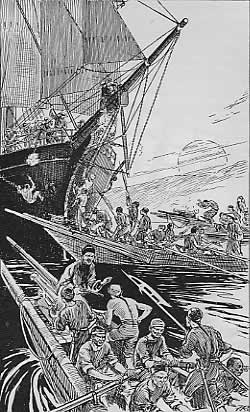
The North Star affair occurred in May 1861 when Chinese pirates attacked the British merchant ship North Star. Several men were killed in the incident, including a Royal Navy officer. The pirates escaped capture with 4,000 dollars' worth of gold.
HMS Lion was the pirate schooner Gata, built in Baltimore in 1820, that the Royal Navy captured in 1823 and took into service. She took part in numerous expeditions against pirates, recaptured some of their prizes, and captured a slave ship. The Navy sold her in 1826.













